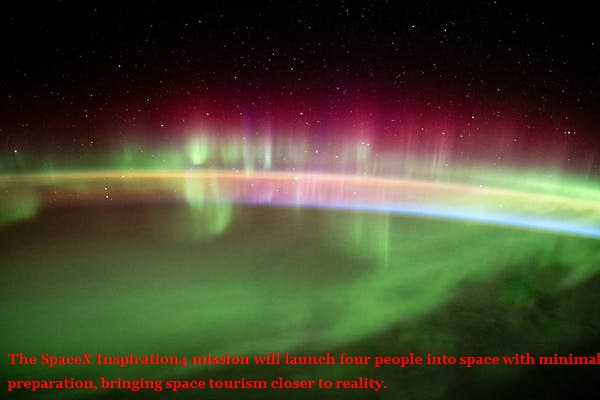The SpaceX Inspiration4 mission will launch four people into space with minimal preparation, bringing space tourism closer to reality.
The next
group of space travelers is scheduled to launch on a SpaceX rocket on Sept.
15, 2021. The Inspiration4 mission, organized and funded by entrepreneur Jared
Isaacman, bills itself as "the first all-civilian mission to orbit"
and represents a new sort of space tourism.
The four astronauts will not be the first visitors to space this year. In recent months, billionaires Richard Branson and Jeff Bezos have launched themselves and a select few others into space on suborbital flights. While there are some similarities between previous launches and Inspiration4 — the mission is funded by a billionaire and uses a rocket designed by another billionaire, Elon Musk — the distinctions are notable. As a space policy specialist, I see Inspiration4 as a watershed moment in space tourism because of its emphasis on public participation and the fact that it will bring average people into orbit for three days.
 |
| A medical assistant, a data engineer, a geoscientist, and millionaire Jared Isaacman are among the four crew members of the Inspiration4 mission.-CC BY-NC-ND via Flickr, Inspiration4/John Kraus |
Why is Inspiration4 unique?
The
destination is the most significant distinction between Inspiration4 and prior
trips this year.
Blue
Origin and Virgin Galactic have taken — and will continue to take – people on
suborbital flights. Their vehicles only travel as far as the edge of space
before returning to Earth a few minutes later. The Inspiration4 crew, on the
other hand, will be able to reach orbit using SpaceX's Falcon 9 rocket and crew
Dragon ship, where they will circle the Earth for three days.
The
four-person crew is likewise unique in comparison to the prior launches. The
mission is led by Isaacman and includes a varied collection of persons. Sian
Proctor, a member of the team, won a sweepstakes among people who utilize
Isaacman's online payment service.
One of
the mission's aims is to raise awareness and finances for St. Jude Children's
Research Hospital, which is a unique component of the mission. As a result,
Isaacman chose Hayley Arceneaux, a St. Jude physician's assistant and childhood
cancer survivor, to take part in the launch. Christopher Sembroski, the final
member, got his seat after a buddy was picked in a charity lottery for St. Jude
and donated it to Sembroski.
The
journey has been dubbed the first "all citizen" space mission because
none of the four participants has had any official astronaut training. Despite
the fact that the rocket and crew capsule are both entirely automated – no one
on board will need to manage any element of the launch or landing - the four
members need far more training than those who flew in suborbital missions. The
team has gone through hours of simulator training, instruction on how to fly a
jet plane, and time in a centrifuge to prepare for the G-forces of launch in
less than six months.
Also read: For migrants who are establishing a new life in Australia, technology is crucial
Another
essential element of the goal has been social outreach. While Bezos and
Branson's flights drew criticism for putting billionaires in space,
Inspiration4 has attempted – with varied results – to make space travel more
approachable The team was recently featured on the cover of Time magazine and
is the subject of a Netflix documentary that is now airing.
A virtual
4-mile run and a planned auction of beer hops that will be flown on the trip
are two more fundraising activities for St. Jude.
What role does space tourism play in the future?
A
important step forward in the development of space tourism is the launch of a
crew of amateur astronauts into orbit. Despite the mission's more inclusive
tone, there are still significant obstacles to overcome before ordinary people
may travel to space.
For one
thing, the price is still rather expensive. Despite the fact that the other
three are not wealthy, Isaacman is a millionaire who spent an estimated $200
million for the trip. Because passengers must train for a mission like this,
they must be able to dedicate substantial time to preparation - time that many
regular people do not have.
Finally,
space remains a hazardous environment, and there will never be a method to
completely eliminate the risk of sending people into space, whether they are
inexperienced citizens or experienced professional astronauts.
Despite
these drawbacks, orbital space tourism is on the way. Inspiration4 is a
critical proof of concept for SpaceX, with the goal of demonstrating the safety
and dependability of their autonomous rocket and capsule systems. Even though
SpaceX isn't focused on space tourism, the firm has numerous tourist missions
scheduled in the coming months. Some of them will even visit the International
Space Station.
Despite
the fact that space remains beyond of reach for the majority of people on
Earth, Inspiration4 is an example of how wealthy space barons' efforts to
include more people on their travels may broaden the attractiveness of an
otherwise exclusive activity.
Achievements in Brief:
The reuse
of orbital-class launch vehicles and cost reduction in the space launch
business are two of SpaceX's major achievements. The most famous of them is the
Falcon 9's first stage's continuous landings and relaunches following a
multi-year campaign to create the reusable technology. SpaceX has used two
different first-stage boosters, B1049 and B1051, nine and ten times, respectively,
as of May 2021. Elon Musk went on to suggest that the fleet leader, B1051, will
be pushed over the initial objective of ten flights.
SpaceX is
a commercial space business, and the majority of its accomplishments are the
product of self-funded development efforts rather than typical US government
cost-plus contracts. As a result, many of its accomplishments are also firsts
for a private corporation.







0 Comments